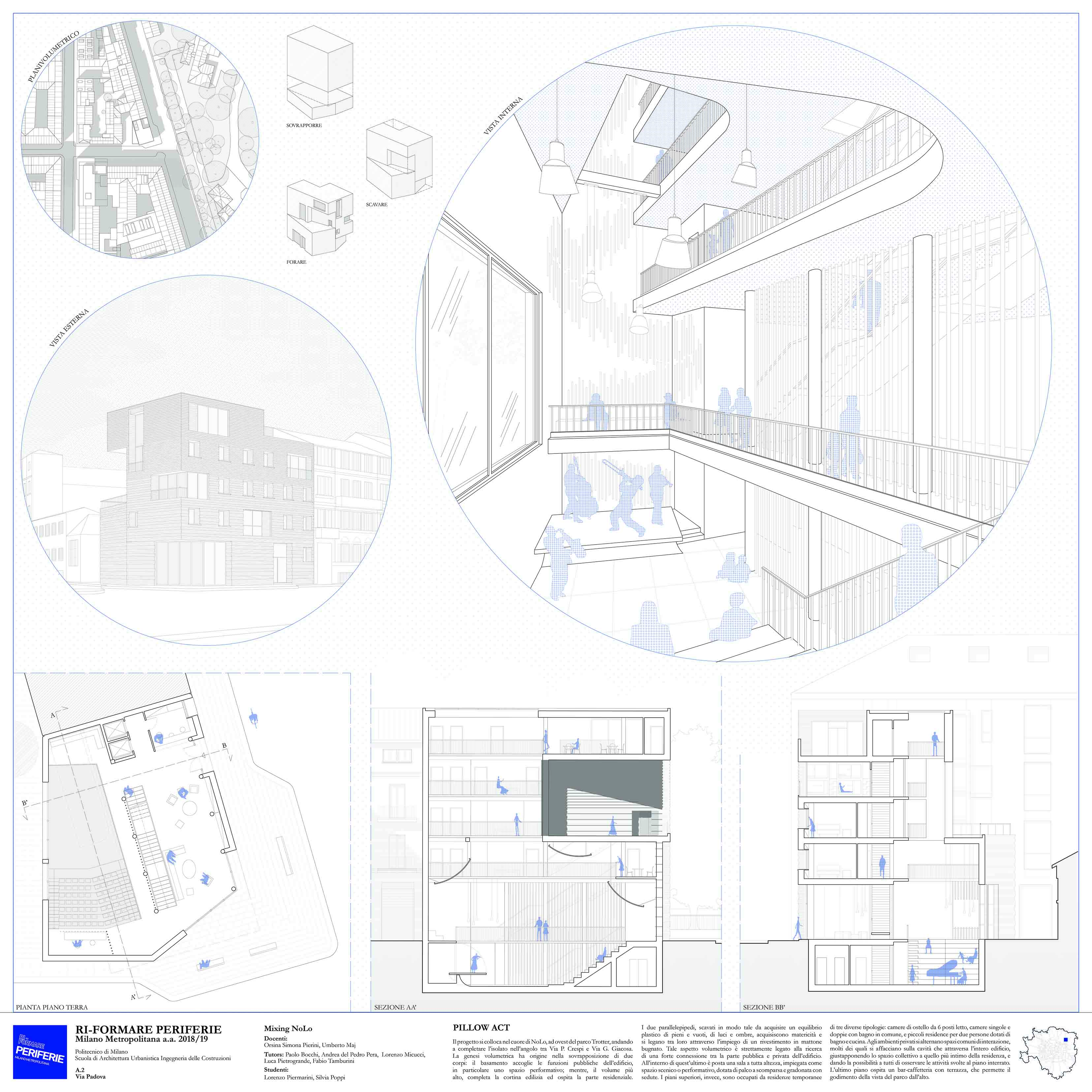Laboratorio di Progettazione Architettonica 3
Docenti: Orsina Simona Pierini, Umberto Maj
[IT]
NoLo è un acronimo (North of Loreto) nato per gioco sulle rive dell’Hudson nel tentativo di dare un’identità proiettiva e cosmopolita ad un’area della prima periferia milanese. Mutua l’appeal della toponomastica spontanea newyorkese (DUMBO “Down Under Manhattan Bridge Overpass” – SOHO “South of Huston Street ) di quartieri un tempo popolari e malfamati divenuti oggetto di stravolgenti fenomeni di gentrificazione upper- class.
Ma prima di diventare il quartiere più attrattivo per gli interessi di appropriazione della creative-class, Nolo era soprattutto Via Padova e Viale Monza, i sottopassi di Centrale ed il dimenticato Trotter.
Di questi luoghi tv, giornali e nuovi media, hanno spesso dato una rappresentazione di ruolo (quella della potenziale Banlieue italiana), sicuramente riduttiva della complessa convivenza di esigenze sociali che qui ha trovato casa dal dopoguerra in poi. Lì dove l’immigrazione multietnica ha sostituito ed affiancato quella nazionale degli anni 60′ che ha portato migliaia di lavoratori nelle fabbriche di Sesto San Giovanni e Greco (Breda, Falk, Magneti Marelli, Pirelli). Lì dove alla rosticceria pugliese si è affiancato il video-noleggio bengalese, ed oggi l’atelier di fotografia.
Progettare in questo contesto significa provare ad esplorare le potenzialità di una condizione evolutiva unica, entro lo stretto margine rimasto fra un futuro gentrificato ( forse paradossalmente impoverito) ed un presente più complesso ove coabitano istanze culturali fortemente eterogenee.
La proposta di lavoro offerta agli studenti è stata quella di indagare le potenzialità della mixité che più propriamente conosciamo (edificio IBRIDO urbano) nella sua sovrapposizione alla mixité di bisogni e desideri culturalmente tanto differenti.
[EN]
NoLo is an acronym (North of Loreto), born for play on the banks of the Hudson River, in an attempt to give a projective and cosmopolitan identity to an area of the first suburbs of Milan. It borrows the appeal of New York’s spontaneous naming (DUMBO “Down Under Manhattan Bridge Overpass” – SOHO “South of Huston Street) of neighborhoods that once where popular and which later became the subject of upsetting phenomena such as upper-class gentrification.
Before becoming the most attractive district for the interests of appropriation of the creative-class, Nolo was above all Via Padova and Viale Monza, the subways of Centrale and the forgotten Trotter park.
TV, newspapers and new media, have often given this area an unfair representation (that one of the potential Italian Banlieue), certainly reducing the complex coexistence of social needs that has found a home there from the post-war period onwards. There, the multiethnic immigration has replaced the national migration of the 60s’ that brought thousands of workers in the factories of Sesto San Giovanni and Greco (Breda, Falk, Magneti Marelli, Pirelli). The pugliese rotisserie was joined by the ‘Bangladeshi video rental,’ and today by the ‘photography studio’.
Designing in this context means trying to explore the potential of a unique evolutionary condition, within the narrow margin left between a gentrified future (perhaps paradoxically impoverished) and a more complex present where highly heterogeneous cultural instances coexist.
The job offered to the students was to investigate the potentialities of the functional mixité (urban HYBRID building) in its overlaying of the intercultural mixiteRi-Formare.
Tav.1
studenti: Lorenzo Piermarini, Silvia Poppi
